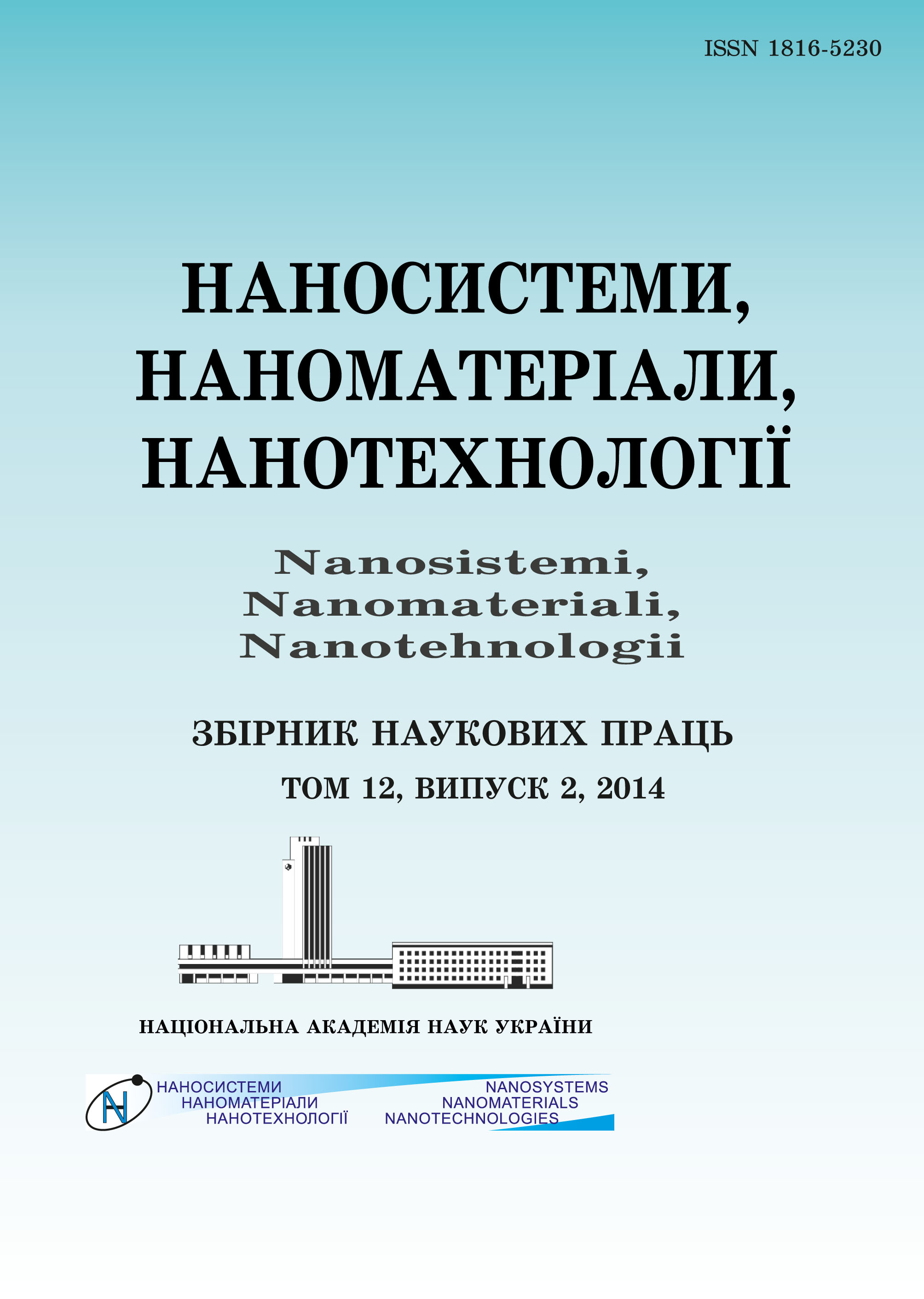|
|
|||||||||
 |
Year 2023 Volume 21, Issue 3 |
|
|||||||
|
|||||||||
Issues/2023/vol. 21 /Issue 3 |
A. R. Imamaliyev, I. R. Amiraslanov, F. F. Yahyayev, and A. A. Hadiyeva
Size Effect of Submicron Barium-Titanate Particles on Its Phase Transitions and Dielectric Properties
583–592 (2023)
PACS numbers: 65.80.-g,68.37.Hk,77.22.Ch,77.80.Bh,78.67.Bf,81.07.Wx,82.60.Qr
The structure, dielectric properties, and phase transitions of ferroelectric barium-titanate (BaTiO3) particles with sizes of 100, 200, 300, 400, and 500 nm are investigated by powder-diffractometry techniques, low-dimensional dielectric spectroscopy and differential scanning calorimetry (DSC), respectively. Analysis of the x-rays’ diffraction spectra shows that, at room temperature for particles of all sizes, there are no signals corresponding to the cubic phase that contradicts the widely used core–shell model. As shown, the transition from cubic phase to tetragonal one shifts downward with a decrease in the BaTiO3-particle size. For particles with a size of 100 nm, this shift is anomalously large and is of about 80?C. The cubic–tetragonal phase-transition enthalpy for these particles is higher by an order of magnitude in comparison with particles of other sizes. The peak corresponding to the tetragonal–orthorhombic transition is not found in the DSC thermogram in the case of 200 nm size particles. These particles are also distinguished by a significantly high value of the dielectric constant, which will make it possible to use these particles as the main component of superparaelectric materials in the future. The results are discussed to reconcile them with each other.
Key words: barium titanate, ferroelectric, phase transition, dielectric permittivity.
https://doi.org/10.15407/nnn.21.03.583
References
- Karin M. Rabe, Matthew Dawber, C?line Lichtensteiger, Charles H. Ahn, and Jean-Marc Triscone, Physics of Ferroelectrics: A Modern Perspective, 105: 1 (2007); https://doi.org/10.1007/978-3-540-34591-6_1
- J. Scott, Ferroelectric Materials for Energy Applications (Wiley–VCH Verlag GmbH & Co. KGaA: 2018).
- K. Uchino, Ferroelectric Devices (CRC Press: 2011).
- Burcu Ertug, American Journal of Engineering Research (AJER), 2, No. 8: 1 (2013); https://www.ajer.org/papers/v2(8)/A0280107.pdf
- A. K. Sharma, B. G. Priyadarshini, B. R. Mehta, and D. Kumar, RSC Advances, 5: 59881(2015): https://doi.org/10.1039/C5RA07923C
- Yu. Garbovskiy, O. Zribi, and A. Glushchenko, Emerging Applications of Ferroelectric Nanoparticles in Materials Technologies, Biology and Medicine, http://dx/doi/org/10.5772/52616
- Markys G. Cain, Characterisation of Ferroelectric Bulk Materials and Thin Films (Springer: 2014).
- K. P. Jayadevan and T. Y. Tseng, Journal of Material Science: Materials of Electronics, 3, No. 8: 3439: (2002); https://doi.org/10.1023/A:1016129318548
- S. Salemzadeh, A. Mellinger, and G. Caruntu, ACS Applied Materials, 20, No. 6: 17506 (2014); http://dx/doi.org/10.1021/am502547h
- P. N. Nikolarakis, I. A. Asimakopoulos, and L. Zoumpoulakis, Journal of Nanomaterials, Article ID 7023437: 1 (2018); https://doi.org/10.1155/2018/7023437
- A. Glushchenko, Ch. Cohen, J. West, F. Li, E. Buyuktanir, and Y. Reznikov, Molecular Crystals and Liquid Crystals, 453: 227 (2006); https://doi.org/10.1080/15421400600653852
- Y. Reznikov, Ferroelectric Colloids in Liquid Crystals: Chemistry, Physics, and Applications (Liquid Crystals Beyond Displays) (Ed. Q. Li) (Hoboken, New Jersey: John Wiley & Sons, Inc.: 2012), p. 403.
- Y. Reznikov, A. Glushchenko, and Y. Garbovskiy, Ferromagnetic and Ferroelectric Nanoparticles in Liquid Crystals (Liquid Crystals with Nano and Microparticles (Eds. J. Lagerwall and G. Scalia) (World Scientific Publishing: 2016)), p. 657.
- H.-H. Liang and J.-Y. Lee, Enhanced Electro-Optical Properties of Liquid Crystals Devices by Doping with Ferroelectric Nanoparticles (Ferroelectrics—Material Aspects) (Eds. M. Lallart) (Croatia: Intech Web. Org.: 2011), p. 193.
- T. D. Ibragimov, A. R. Imamaliyev, and G. M. Bayramov, Optik, 127: 1217 (2016); https://doi.org/ 10.1016/j.ijleo.2015.10.225
- T. D. Ibragimov, A. R. Imamaliyev, and G. M. Bayramov, Ferroelectrics, 495: 62 (2016): doi:10.1080/00150193.2016.1136732
- A. R. Imamaliyev, Sh. A. Humbatov, and M. A. Ramazanov, Beilstein Journal of Nanotechnology, 9: 824 (2018).
- R. Basu, Phys. Rev. E, 89: 022508 (2014); https://doi.org/10.1103/PhysRevE.89.022508
- S. Wada, T. Hoshina, H. Yasuno, S.-M. Nam, H. Kakameto, H. Tsurumi, and M. Yashima, Journal of Korean Physical Society, 46, No. 1: 303 (2005).
- M. Anliker, H. R. Brugger, and W. Kanzig, Helvetica Physica Acta, 27: 99 (1954).
- C. Fang, D.X. Zhou, and Sh. P. Gong, Physica B, 406: 1317 (2011); doi:10.1016/j.physb.2011.01.024
- M. Tanaka and Y. Makino, Ferroelectrics Lett., 24: 13(1998); https://doi.org/10.1080/ 07315179808204451
- K. Uchino, E. Sadanaga, and T. Hirose, Journal of American Ceramic Society, 72: 1555 (1989).
- P. Sedykh, D. Michel, E. Charnaya, and J. Haase, Ferroelectrics, 400: 135 (2010); https://doi.org/10.1080/00150193.2010.505514
- Powder Diffraction: Theory and Practice (Eds. R. E. Dinnebier and S. J. L. Billinge) (Cambridge: RSC Publisher: 2008).
- V. K. Pecharsky and P. Y. Zavalij, Fundamentals of Powder Diffraction and Structural Characterization of Materials (Springer: 2022).
- G. R. Gorur, Dielectrics in the Electric Field (CRC Press–Taylor and Francis Group: 2017).
- Ch. Kittel, Introduction to Solid State Physics (John Willey and Sons Inc.: 2005).
- K. Binder, Ferroelectrics, 73: 43 (1987).
- J. Yu and J. Chu, Encyclopedia of Nanoscience and Nanotechnology (Ed. H. S. Nalwa) (2004), vol. 6, p. 389.
- T. Hoshina, H. Yasuno, H. Kakameto, T. Tsurumi, and S. Wada, Ferroelectrics, 353: 55 (2007); http://dx.doi.org/10.1080/00150190701367069
 This article is licensed under the Creative Commons Attribution-NoDerivatives 4.0 International License ©2003—2023 NANOSISTEMI, NANOMATERIALI, NANOTEHNOLOGII G. V. Kurdyumov Institute for Metal Physics of the National Academy of Sciences of Ukraine. E-mail: tatar@imp.kiev.ua Phones and address of the editorial office About the collection User agreement |